Elk
The elk (Cervus canadensis) or wapiti is one of the largest species within the deer family, Cervidae, and one of the largest terrestrial mammals in North America and Northeast Asia. This animal should not be confused with the still larger moose (Alces alces) of North America, alternatively known as "elk" in British English and related names in other European languages (German elch, Danish elg, French élan), in reference to populations in Eurasia. Elk range in forest and forest-edge habitat, feeding on grasses, plants, leaves, and bark. Male elk have large antlers which are shed each year. Males also engage in ritualized mating behaviors during the rut, including posturing, antler wrestling (sparring), and bugling, a loud series of vocalizations that establishes dominance over other males and attracts females.
| Elk | |
|---|---|
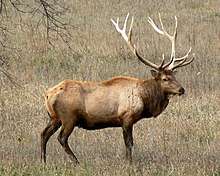 | |
| A bull (male) in Nebraska | |
_9_(8290359165).jpg) | |
| A cow (female) in Colorado | |
| Scientific classification | |
| Kingdom: | Animalia |
| Phylum: | Chordata |
| Class: | Mammalia |
| Order: | Artiodactyla |
| Family: | Cervidae |
| Subfamily: | Cervinae |
| Genus: | Cervus |
| Species: | C. canadensis |
| Binomial name | |
| Cervus canadensis | |
| Subspecies | |
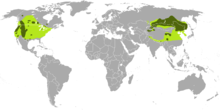 | |
| Former (light green) and current (dark green) native ranges of Cervus canadensis | |
| Synonyms | |
|
Various Cervus elaphus subspecies | |
Although it is currently native to North America and eastern Asia, it had a much wider distribution in the past. Populations were present across Eurasia into Western Europe during the Late Pleistocene, and survived into the early Holocene in southern Sweden and the Alps. The elk has adapted well in countries where it has been introduced, including Argentina and New Zealand. Its adaptability may in fact threaten endemic species and the ecosystems into which it has been introduced.
Elk are susceptible to a number of infectious diseases, some of which can be transmitted to livestock. Efforts to eliminate infectious diseases from elk populations, largely by vaccination, have had mixed success. Some cultures revere the elk as having spiritual significance. In parts of Asia, antlers and their velvet are used in traditional medicines. Elk are hunted as a game species. Their meat is leaner and higher in protein than beef or chicken. Elk were long believed to belong to a subspecies of the European red deer (Cervus elaphus), but evidence from many mitochondrial DNA genetic studies beginning in 1998 shows that the two are distinct species. Key morphological differences that distinguish C. canadensis from C. elaphus are the former's wider rump patch and paler-hued antlers.
Naming and etymology
Early European explorers in North America, who were familiar with the smaller red deer of Europe, thought that the larger North American animal resembled a moose, and consequently gave it the name elk, which is the common European name for moose. The word elk is related to the Latin alces, Old Norse elgr, Scandinavian elg/älg and German Elch, all of which refer to the animal known in North America as the moose.[3]
The name wapiti is from the Shawnee and Cree word waapiti, meaning "white rump".[4] This name is used in particular for the Asian subspecies (the Altai wapiti, Tian Shan wapiti, Manchurian wapiti and Alashan wapiti), because in Eurasia the name elk continues to be used for the moose.
The Asian subspecies are sometimes referred to as the maral, but this name applies primarily to the Caspian red deer (Cervus elaphus maral), a subspecies of the red deer. There is a subspecies of wapiti in Mongolia called the Altai wapiti (Cervus canadensis sibiricus),[5] also known as the Altai maral.
Taxonomy
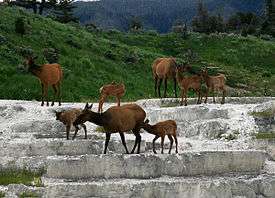
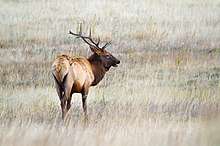
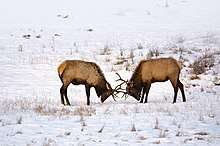
Members of the genus Cervus (and hence early relatives or possible ancestors of the elk) first appear in the fossil record 25 million years ago, during the Oligocene in Eurasia, but do not appear in the North American fossil record until the early Miocene.[6] The extinct Irish elk (Megaloceros) was not a member of the genus Cervus, but rather the largest member of the wider deer family (Cervidae) known from the fossil record.[7]
Until recently, red deer and elk were considered to be one species, Cervus elaphus.[5][8] However, mitochondrial DNA studies, conducted on hundreds of samples in 2004 from red deer and elk subspecies as well as other species of the Cervus deer family, strongly indicate that elk, or wapiti, should be a distinct species, namely Cervus canadensis.[9] The previous classification had over a dozen subspecies under the C. elaphus species designation; DNA evidence concludes that elk are more closely related to Thorold's deer and even sika deer than they are to the red deer.[9] Elk and red deer produce fertile offspring in captivity, and the two species have freely inter-bred in New Zealand's Fiordland National Park, where the cross-bred animals have all but removed the pure elk blood from the area.[10] Key morphological differences that distinguish C. canadensis from C. elaphus are the former's wider rump patch and paler-hued antlers.[11]
Subspecies
There are numerous subspecies of elk described, with six from North America and four from Asia, although some taxonomists consider them different ecotypes or races of the same species (adapted to local environments through minor changes in appearance and behavior). Populations vary in antler shape and size, body size, coloration and mating behavior. DNA investigations of the Eurasian subspecies revealed that phenotypic variation in antlers, mane and rump patch development are based on "climatic-related lifestyle factors".[12] Of the six subspecies of elk known to have inhabited North America in historical times, four remain, including the Roosevelt's (C. canadensis roosevelti), tule (C. canadensis nannodes), Manitoban (C. canadensis manitobensis) and Rocky Mountain elk (C. canadensis nelsoni).[13] The eastern elk (C. canadensis canadensis) and Merriam's elk (C. canadensis merriami) subspecies have been extinct for at least a century.[14][15]
Four subspecies described in Asia include the Altai wapiti (C. canadensis sibiricus) and the Tianshan wapiti (C. canadensis songaricus). Two distinct subspecies found in China and Korea are the Manchurian wapiti (C. canadensis xanthopygus) and the Alashan wapitis (C. canadensis alashanicus). The Manchurian wapiti is darker and more reddish in coloration than the other populations. The Alashan wapiti of north central China is the smallest of all subspecies, has the lightest coloration and is the least studied.[10] Biologist Valerius Geist, who has written on the world's various deer species, holds that there are only three subspecies of elk. Geist recognizes the Manchurian and Alashan wapiti, but places all other elk into C. canadensis canadensis, claiming that classification of the four surviving North American groups as subspecies is driven, at least partly, for political purposes to secure individualized conservation and protective measures for each of the surviving populations.[16]
Recent DNA studies suggest that there are no more than three or four subspecies of elk. All American forms, aside from possibly the tule and Roosevelt's elk, seem to belong to one subspecies (Cervus canadensis canadensis). Even the Siberian elk (Cervus canadensis sibiricus) are more or less identical to the American forms and therefore may belong to this subspecies, too. However, the Manchurian wapiti (Cervus canadensis xanthopygus) is clearly distinct from the Siberian forms, but not distinguishable from the Alashan wapiti. The Chinese forms the Sichuan deer, Kansu red deer, and Tibetan red deer belong also to the wapitis and were not distinguishable from each other by mitochondrial DNA studies.[9] These Chinese subspecies are sometimes treated as a distinct species, namely the Central Asian red deer (Cervus wallichi), which also includes the Kashmir stag.[17]
- North American group
- Roosevelt's elk (C. c. roosevelti)
- Tule elk (C. c. nannodes)
- Manitoban elk (C. c. manitobensis)
- Rocky Mountain elk (C. c. nelsoni)
- Eastern elk (C. c. canadensis; extinct)
- Merriam's elk (C. c. merriami; extinct)
- Eastern group
- Altai wapiti (C. c. sibiricus)
- Tian Shan wapiti (C. c. songaricus)
- Manchurian wapiti (C. c. xanthopygus)
- Alashan wapiti (C. c. alashanicus)
- Southern group (Central Asian red deer)
- Sichuan deer (C. c. macneilli)
- Kansu red deer (C. c. kansuensis)
- Tibetan red deer (C. c. wallichii)
- Kashmir stag (C. c. hanglu)
 Illustration of eastern elk
Illustration of eastern elk_Altai_wapiti.png) Illustration of Altai wapiti
Illustration of Altai wapiti_Bedford's_deer.png) Illustration of Manchurian wapiti
Illustration of Manchurian wapiti_Hangul.png) Illustration of Kashmir stag
Illustration of Kashmir stag
Anatomy
The elk is a large animal of the ungulate order Artiodactyla, possessing an even number of toes on each foot, similar to those of camels, goats and cattle. It is a ruminant species, with a four-chambered stomach, and feeds on grasses, plants, leaves and bark. During the summer, elk eat almost constantly, consuming between 4 and 7 kilograms (8.8 and 15.4 lb) of vegetation daily.[18] In North America, males are called bulls, and females are called cows. In Asia, stag and hind, respectively, are sometimes used instead.
Elk are more than twice as heavy as mule deer and have a more reddish hue to their hair coloring, as well as large, buff-colored rump patches and smaller tails. Moose are larger and darker than elk; bulls have distinctively different antlers. Elk gather in herds, while moose are solitary. Elk cows average 225 to 241 kg (496 to 531 lb), stand 1.3 m (4.3 ft) at the wither, and are 2.1 m (6.9 ft) from nose to tail. Bulls are some 40% larger than cows at maturity, weighing an average of 320 to 331 kg (705 to 730 lb), standing 1.5 m (4.9 ft) at the wither and averaging 2.45 m (8.0 ft) in length[19][20] while large males reach 1.7 m (5.6 ft) tall at wither and 3 m (9.8 ft) in length.[21] The largest of the subspecies is the Roosevelt elk (C. c. roosevelti), found west of the Cascade Range in the U.S. states of California, Oregon and Washington, and in the Canadian province of British Columbia. Roosevelt elk have been reintroduced into Alaska, where the largest males are estimated to weigh up to 600 kg (1,300 lb).[22] More typically, male Roosevelt elk weigh around 300 to 544 kg (661 to 1,199 lb), while females weigh 260 to 285 kg (573 to 628 lb).[23][24] The smallest-bodied subspecies is the tule elk (C. c. nannodes), which weighs from 170 to 250 kg (370 to 550 lb) in both sexes.[23]
Only the males have antlers, which start growing in the spring and are shed each winter. The largest antlers may be 1.2 meters (3.9 ft) long and weigh 18 kilograms (40 lb).[25] Antlers are made of bone which can grow at a rate of 2.5 centimeters (0.98 in) per day. While actively growing, the antlers are covered with and protected by a soft layer of highly vascularised skin known as velvet. The velvet is shed in the summer when the antlers have fully developed. Bull elk may have eight or more tines on each antler; however, the number of tines has little to do with the age or maturity of a particular animal. The Siberian and North American elk carry the largest antlers while the Altai wapiti have the smallest.[10] The formation and retention of antlers is testosterone-driven.[26] After the breeding season in late fall, the level of pheromones released during estrus declines in the environment and the testosterone levels of males drop as a consequence. This drop in testosterone leads to the shedding of antlers, usually in the early winter.
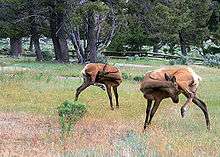
During the fall, elk grow a thicker coat of hair, which helps to insulate them during the winter. Males, females and calves of Siberian and North American elk all grow thin neck manes; female and young Manchurian and Alaskan wapitis do not.[16] By early summer, the heavy winter coat has been shed, and elk are known to rub against trees and other objects to help remove hair from their bodies. All elk have small and clearly defined rump patches with short tails. They have different coloration based on the seasons and types of habitats, with gray or lighter coloration prevalent in the winter and a more reddish, darker coat in the summer. Subspecies living in arid climates tend to have lighter colored coats than do those living in forests.[27] Most have lighter yellow-brown to orange-brown coats in contrast to dark brown hair on the head, neck, and legs during the summer. Forest-adapted Manchurian and Alaskan wapitis have darker reddish-brown coats with less contrast between the body coat and the rest of the body during the summer months.[10] Calves are born spotted, as is common with many deer species, and they lose their spots by the end of summer. Adult Manchurian wapiti may retain a few orange spots on the back of their summer coats until they are older. This characteristic has also been observed in the forest-adapted European red deer.[10]
Behavior

Adult elk usually stay in single-sex groups for most of the year. During the mating period known as the rut, mature bulls compete for the attention of the cow elk and will try to fend off rival bulls from their harem. Rival bulls challenge opponents by bellowing, or bugling, and by paralleling each other, walking back and forth. This allows potential combatants to assess the other's antlers, body size and fighting prowess.[28] If neither bull backs down, they engage in antler wrestling, and bulls sometimes sustain serious injuries.[29] Bulls also dig holes in the ground called wallows, in which they urinate and roll their body.[30][29] A male elk's urethra points upward so that urine is sprayed almost at a right angle to the penis.[31] The urine soaks into their hair and gives them a distinct smell which attracts cows.[29]
Dominant bulls follow groups of cows during the rut, from August into early winter. A bull will defend his harem of 20 cows or more from competing bulls and predators.[32] It is only the mature bulls that usually have large harems, and breeding success peaks at about eight years of age. Bulls between two and four years and over 11 years of age rarely have harems, and spend most of the rut on the periphery of larger harems. Young and old bulls that do acquire a harem usually acquire it later in the breeding season than do bulls in their prime. A bull with a harem rarely feeds, and he may lose up to 20 percent of his body weight during the rut. Bulls that enter the rut in poor condition are less likely to keep their harems through to the peak conception period or have the strength to survive the rigors of the oncoming winter.[28]
Bulls have a loud vocalization consisting of screams known as bugling, which can be heard for miles. Bugling is often associated with an adaptation to open environments such as parklands, meadows, and savannas, where sound can travel great distances. Females are attracted to the males that bugle more often and have the loudest call.[33] Unusual for a vocalization produced by a large animal, buglings can reach a frequency of 4000 Hz. This is achieved by blowing air from the glottis through the nasal cavities. Elk can produce deeper pitched (150 Hz) sounds using the larynx.[34]
Reproduction and lifecycle
Female elk have a short estrus cycle of only a day or two, and matings usually involve a dozen or more attempts. By the autumn of their second year, females can produce one and, very rarely, two offspring, although reproduction is most common when cows weigh at least 200 kilograms (440 lb).[35] The gestation period is 240 to 262 days and the offspring weigh between 15 and 16 kilograms (33 and 35 lb). When the females are near to giving birth, they tend to isolate themselves from the main herd, and will remain isolated until the calf is large enough to escape predators.[29] Calves are born spotted, as is common with many deer species, and they lose their spots by the end of summer. Manchurian wapiti may retain a few orange spots on the back of their summer coats until they are older. After two weeks, calves are able to join the herd, and are fully weaned at two months of age.[36] Elk calves are as large as an adult white-tailed deer by the time they are six months old.[37] The offspring will remain with their mothers for almost a year, leaving about the time that the next season's offspring are produced.[33] The gestation period is the same for all subspecies.
Elk live 20 years or more in captivity but average 10 to 13 years in the wild. In some subspecies that suffer less predation, they may live an average of 15 years in the wild.[38]
Predators and defensive tactics
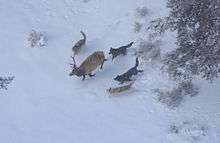
In North America, wolf and coyote packs and the solitary cougar are the most likely predators, although brown and black bears also prey on elk.[33] Coyote packs mostly prey on elk calves, though they can sometimes take a winter- or disease-weakened adult.[39] In the Greater Yellowstone Ecosystem which includes Yellowstone National Park, bears are the most significant predators of calves.[40] Although grizzlies have been documented to hunt elk, there are no documented cases when mature healthy bulls are killed by grizzlies; however, they do occasionally kill the bears instead.[41]
Male elk retain their antlers for more than half the year and are less likely to group with other males when they have antlers. Antlers provide a means of defense, as does a strong front-leg kick, which is performed by either sex if provoked. Once the antlers have been shed, bulls tend to form bachelor groups which allow them to work cooperatively at fending off predators. Herds tend to employ one or more scouts while the remaining members eat and rest.[33]
After the rut, females form large herds of up to 50 individuals. Newborn calves are kept close by a series of vocalizations; larger nurseries have an ongoing and constant chatter during the daytime hours. When approached by predators, the largest and most robust females may make a stand, using their front legs to kick at their attackers. Guttural grunts and posturing effectively deter all but the most determined predators.[33]
Wapiti in New Zealand have no natural predators.[42]
Migration
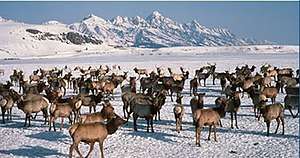
As is true for many species of deer, especially those in mountainous regions, elk migrate into areas of higher altitude in the spring, following the retreating snows, and the opposite direction in the fall. Hunting pressure also impacts migration and movements.[43] During the winter, they favor wooded areas and sheltered valleys for protection from the wind and availability of tree bark to eat. Roosevelt elk are generally non-migratory due to less seasonal variability of food sources.[33]
The Greater Yellowstone Ecosystem elk herd numbers over 200,000 individuals and during the spring and fall, they take part in the longest elk migration in the continental U.S. Elk in the southern regions of Yellowstone National Park and in the surrounding National Forests migrate south towards the town of Jackson, Wyoming, where they winter for up to six months on the National Elk Refuge. Conservationists there ensure the herd is well fed during the harsh winters.[44] Many of the elk that reside in the northern sections of the Greater Yellowstone Ecosystem migrate to lower altitudes in Montana, mainly to the north and west.
Diet
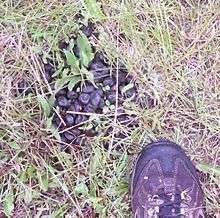
Elk are ruminants and therefore have four-chambered stomachs. Unlike white-tailed deer and moose, which are primarily browsers, elk are similar to cattle in that they are primarily grazers. But like other deer, they also browse.[45][46] Elk have a tendency to do most of their feeding in the mornings and evenings, seeking sheltered areas in between feedings to digest. Their diets vary somewhat depending on the season, with native grasses being a year-round supplement, tree bark being consumed in winter and forbs and tree sprouts during the summer. Elk consume an average of 9.1 kilograms (20 lb) of various vegetation daily.[47] Particularly fond of aspen sprouts which rise in the spring, elk have had some impact on aspen groves which have been declining in some regions where elk exist.[48]
Range and wildlife managers conduct surveys of elk pellet groups to monitor populations and resource use.[49][50]
Parasites and disease
At least 53 species of protist and animal parasites have been identified in elk.[51] Most of these parasites seldom lead to significant mortality among wild or captive elk. Parelaphostrongylus tenuis (brainworm or meningeal worm) is a parasitic nematode known to affect the spinal cord and brain tissue of elk and other species, leading to death.[52] The definitive host is the white-tailed deer, in which it normally has no ill effects. Snails and slugs, the intermediate hosts, can be inadvertently consumed by elk during grazing.[3] The liver fluke Fascioloides magna and the nematode Dictyocaulus viviparus are also commonly found parasites that can be fatal to elk.[53] Since infection by either of these parasites can be lethal to some commercial livestock species, their presence in elk herds is of some concern.
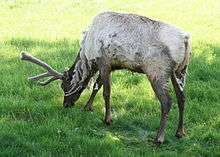
Chronic wasting disease, transmitted by a misfolded protein known as a prion, affects the brain tissue in elk, and has been detected throughout their range in North America. First documented in the late 1960s in mule deer, the disease has affected elk on game farms and in the wild in a number of regions. Elk that have contracted the disease begin to show weight loss, increased watering needs, disorientation, and listlessness, and at an advanced stage, the disease leads to death. The disease is similar to, but not the same as mad cow disease, and no risks to humans have been documented, nor has the disease been demonstrated to pose a threat to domesticated cattle.[54] In 2002, South Korea banned the importation of elk antler velvet due to concerns about chronic wasting disease.[55]
The Gram-negative bacterial disease brucellosis occasionally affects elk in the Greater Yellowstone Ecosystem, the only place in the U.S. where the disease is still known to exist. In domesticated cattle, brucellosis causes infertility, abortions, and reduced milk production. It is transmitted to humans as undulant fever, producing influenza-like symptoms that may last for years. Though bison are more likely to transmit the disease to other animals, elk inadvertently transmitted brucellosis to horses in Wyoming and cattle in Idaho. Researchers are attempting to eradicate the disease through vaccinations and herd-management measures, which are expected to be successful.[56] Nevertheless, research has been ongoing since 2002, and a successful vaccine has yet to be developed as of 2016.[57]
A recent necropsy study of captive elk in Pennsylvania attributed the cause of death in 33 of 65 cases to either gastrointestinal parasites (21 cases, primarily Eimeria sp. and Ostertagia sp.) or bacterial infections (12 cases, mostly pneumonia).[58]
Elk hoof disease was first noticed in the state of Washington in the late 1990s in the Cowlitz River basin, with sporadic reports of deformed hooves. Since then, the disease has spread rapidly with increased sightings throughout southwest Washington and into Oregon. The disease is characterised by deformed, broken, or missing hooves and leads to severe lameness in elk. The primary cause is not known, but it is associated with treponeme bacteria, which are known to cause digital dermatitis in commercial livestock. The mode of transmission is also not known, but it appears to be highly contagious among elk. Studies are being undertaken by government departments to determine how to halt or eliminate the disease.[59][60][61]
Ecology
Distribution
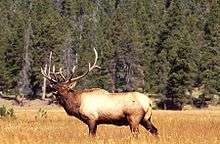
Modern subspecies are descended from elk that once inhabited Beringia, a steppe region between Asia and North America that connected the two continents during the Pleistocene. Beringia provided a migratory route for numerous mammal species, including brown bear, camel, horse, caribou, and moose, as well as humans.[62] As the Pleistocene came to an end, ocean levels began to rise; elk migrated southwards into Asia and North America. In North America they adapted to almost all ecosystems except for tundra, true deserts, and the gulf coast of the U.S. The elk of southern Siberia and central Asia were once more widespread but today are restricted to the mountain ranges west of Lake Baikal including the Sayan and Altai Mountains of Mongolia and the Tianshan region that borders Kyrgyzstan, Kazakhstan, and China's Xinjiang Province.[1] The habitat of Siberian elk in Asia is similar to that of the Rocky Mountain subspecies in North America. During the Late Pleistocene their range was much more extensive, being distributed across Eurasia, with remains being found as far west as France. These populations are most closely related to modern Asian populations of the elk. Their range collapsed at the start of the Holocene, due to them being specialized to cold periglacial tundrasteppe habitat, which was largely replaced with closed forest, being outcompeted by red deer in these conditions. Relictual populations survived into the early Holocene in southern Sweden and the Alps, where the environment remained favorable.[63]
Throughout their range, they live in forest and in forest edge habitat, similar to other deer species. In mountainous regions, they often dwell at higher elevations in summer, migrating down slope for winter. The highly adaptable elk also inhabit semi-deserts in North America, such as the Great Basin. Manchurian and Alashan wapiti are primarily forest dwellers and their smaller antler size is a likely adaptation to a forest environment.
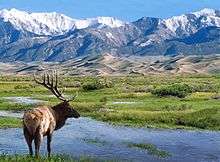
Introductions
The Rocky Mountain elk subspecies has been reintroduced by hunter-conservation organizations in the Appalachian region of the eastern U.S., where the now extinct eastern elk once lived.[64] After elk were reintroduced in the states of Kentucky, North Carolina and Tennessee, they migrated into the neighboring states of Virginia and West Virginia, and have established permanent populations there.[65] In 2017, a male elk, likely from the Smoky Mountains population, was sighted in South Carolina for the first time in nearly 300 years.[66] Elk have also been reintroduced to a number of other states, including Pennsylvania,[67][68] Michigan, Wisconsin, Missouri [69] and Etolin and Afognak Islands in Alaska.[70] Reintroduction of the elk into Ontario began in the early 20th century, and is ongoing with limited success.[71] As of 1989, population figures for the Rocky Mountain subspecies were 782,500, and estimated numbers for all North American subspecies exceeded 1 million.[72] Prior to the European colonization of North America, there were an estimated 10 million elk on the continent.[19]
Outside their native habitat, elk and other deer species, especially white-tailed deer, were introduced in areas that previously had few, if any, large native ungulates. Brought to these countries for hunting and ranching for meat, hides and antler velvet, they have proven highly adaptable and have often had an adverse impact on local ecosystems. Elk and red deer were introduced to Argentina in the early 20th century.[73] There they are now considered an invasive species, encroaching on Argentinian ecosystems where they compete for food with the indigenous Chilean huemul and other herbivores.[74] This negative impact on native animal species has led the IUCN to identify the elk as one of the world's 100 worst invaders.[75]
The introduction of deer to New Zealand began in the middle of the 19th century, and current populations are primarily European red deer, with only 15 percent being elk.[76] There is significant hybridization of elk with the more numerous red deer to the extent that pure elk may no longer exist in the wild in New Zealand. These deer have had an adverse impact on forest regeneration of some plant species, as they consume more palatable species which are replaced with those that are less favored by the elk. The long-term impact will be an alteration of the types of plants and trees found, and in other animal and plant species dependent upon them.[77] As in Chile and Argentina, the IUCN has declared that red deer and elk populations in New Zealand are an invasive species.[75]
Cultural references
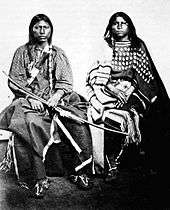
Elk have played an important role in the cultural history of a number of peoples. Neolithic petroglyphs from Asia depict antler-less female elk, which have been interpreted as symbolizing life and sustenance. They were also frequently overlaid with boats and associated with rivers, suggesting that they also represented paths to the underworld.[78] Petroglyphs of elk were carved into cliffs by the Anasazi of the southwestern U.S. hundreds of years ago.[79] The elk was of particular importance to the Lakota, and played a spiritual role in their society. The male elk was admired for its ability to attract mates and Lakota men will play a courting flute imitating a bulging elk to attract women. Men would like use elk antlers as love charms and wore clothes decorated with elk images.[80]
The Rocky Mountain elk is the official state animal for Utah.[81] An image of an elk and a moose appear on the state seal and flag of Michigan.[82] The Benevolent and Protective Order of Elks (B.P.O.E.) chose the elk as its namesake because a number of its attributes seemed appropriate for cultivation by members of the fraternity. A representation of the majestic head of the male, with its spreading antlers, was adopted as the first badge of the Order; and is still the most conspicuous element of its copyrighted fraternal emblem.[83] A prized possession of many members of the B.P.O.E. are jewel encrusted, gold mounted elk teeth – which are actually ivory.[84]
Commercial uses
Although breakdown figures for each game species are not available in the 2006 National Survey from the U.S. Fish and Wildlife Service, hunting of wild elk is most likely the primary economic impact.[85]
While elk are not generally harvested for meat production on a large scale, some restaurants offer the meat as a specialty item and it is also available in some grocery stores. The meat has a taste somewhere between beef and venison and is higher in protein and lower in fat and cholesterol than beef, pork, and chicken.[86] Elk meat is also a good source of iron, phosphorus and zinc.[87]
A male elk can produce 10 to 11 kilograms (22 to 24 lb) of antler velvet annually and on ranches in the United States, Canada and New Zealand, this velvet is collected and sold to markets in East Asia, where it is used in medicine. Velvet is also considered by some cultures to be an aphrodisiac.[55] However, consuming velvet from elk in North America may be risky since velvet from animals infected with chronic wasting disease may contain prions that could result in a human getting variant Creutzfeldt–Jakob disease.[88]
Antlers are also used in artwork, furniture and other novelty items. All Asian subspecies, along with other deer, have been raised for their antlers in central and eastern Asia by Han Chinese, Turkic peoples, Tungusic peoples, Mongolians, and Koreans. Elk farms are relatively common in North America and New Zealand.[76]
Elk hides have been used for thousands of years for tepee covering, blankets, clothing and footwear. Modern uses are more decorative, but elk skin shoes, gloves and belts are not uncommon.[19]
Since 1967, the Boy Scouts of America have assisted employees at the National Elk Refuge in Wyoming by collecting the antlers which are shed each winter. The antlers are then auctioned, with 80% of the proceeds returned to the refuge. In 2010, 2,520 kilograms (5,560 lb) of antlers were auctioned, bringing in over $46,000.[89]
See also
References
- Brook, S.M.; Pluháček, J.; Lorenzini, R.; Lovari, S.; Masseti, M. & Pereladova, O. (2016). "Cervus canadensis". IUCN Red List of Threatened Species. 2016: e.T55997823A55997871. doi:10.2305/IUCN.UK.2016-2.RLTS.T55997823A55997871.en.
- Erxleben, J.C.P. (1777) Anfangsgründe der Naturlehre and Systema regni animalis. Göttingen.
- Fergus, Chuck. "Elk" (PDF). Pennsylvania Game Commission. Retrieved 2010-12-03.
- "Wapiti". The Canadian Encyclopedia. Historica Canada. Retrieved 23 December 2016.
- Grubb, P. (2005). "Order Artiodactyla". In Wilson, D.E.; Reeder, D.M (eds.). Mammal Species of the World: A Taxonomic and Geographic Reference (3rd ed.). Johns Hopkins University Press. pp. 662–663. ISBN 978-0-8018-8221-0. OCLC 62265494.
- Verts, B. J.; Carraway, Leslie N. (August 1998). Land Mammals of Oregon. University of California. p. 464. ISBN 978-0-520-21199-5.
- "The Case of the Irish Elk". University of California, Berkeley. Archived from the original on 2005-11-11. Retrieved 2010-12-03.
- Lovari, S.; Herrero. J., Conroy; J., Maran; T., Giannatos; G., Stubbe; M., Aulagnier; S., Jdeidi; T., Masseti; M. Nader, I.; de Smet, K.; et al. (2008). "Cervus elaphus". IUCN Red List of Threatened Species. 2008. Retrieved 7 Dec 2010.CS1 maint: ref=harv (link)
- Ludt, Christian J.; Schroeder, Wolf; Rottmann, Oswald; Kuehn, Ralph (2004). "Mitochondrial DNA phylogeography of red deer (Cervus elaphus)". Molecular Phylogenetics and Evolution. 31 (3): 1064–1083. doi:10.1016/j.ympev.2003.10.003. PMID 15120401.
- Geist, Valerius (1998). Deer of the World: Their Evolution, Behavior, and Ecology. Mechanicsburg, PA: Stackpole Books. pp. 211–219. ISBN 978-0-8117-0496-0. OCLC 37713037.
- Groves, Colin (2006). "The genus Cervus in eastern Eurasia" (PDF). European Journal of Wildlife Research. 52: 14–22. doi:10.1007/s10344-005-0011-5. Archived from the original (PDF) on 2014-06-29. Retrieved 2014-08-02.
- Groves, Colin (2005). "The genus Cervus in eastern Eurasia". European Journal of Wildlife Research. 52: 14–22. doi:10.1007/s10344-005-0011-5.
- Keck, Stu. "Elk (Cervus canadensis)". Bowhunting.net. Archived from the original on July 6, 2010. Retrieved 2010-12-03.
- Gerhart, Dorothy C. "Skull and Antlers of Extinct Eastern Elk Unearthed at Iroquois National Wildlife Refuge in Northwestern N.Y." U.S. Fish and Wildlife Service. Retrieved 2010-12-04.
- Allen, Craig. "Elk Reintroductions". U.S. Geological Survey. Archived from the original on 2006-09-27. Retrieved 2010-12-04.
- Geist, Valerius (June 1993). Elk Country. Minneapolis: NorthWord Press. ISBN 978-1-55971-208-8.
- Mattioli (2011). Family Cervidae (Deer). (350-443). In: Wilson, D. E., Mittermeier, R. A., (Hrsg.). Handbook of the Mammals of the World. Volume 2: Hooved Mammals. Lynx Edicions, 2009. ISBN 978-84-96553-77-4
- "Elk Habitat". Rocky Mountain Elk Foundation. Retrieved 2007-06-04.
- "Fast Facts". Rocky Mountain Elk Foundation. Retrieved 2010-12-04.
- "North American Mammals: Cervus elaphus". Mnh.si.edu. Retrieved 2012-11-08.
- Anthony Alan Arsenault, 2008, "Saskatchewan Elk (Cervus elaphus) Management Plan - Update", p.2: "1.1.2 - Physical Description", Fish and Wildlife Technical Report 2008-03, Saskatchewan Ministry of Environment, Fish, and Wildlife Branch
- Eide, Sterling. "Roosevelt Elk". Alaska Department of Fish and Game. Retrieved 2010-12-04.
- "Cervus elaphus - Red deer (North American Elk) (Species)". Wildpro.twycrosszoo.org. Retrieved 2012-11-08.
- Robb, Bob (January 2001). The Ultimate Guide to Elk Hunting. The Lyons Press. ISBN 1-58574-180-9.
- "What Are Elk?". Rocky Mountain Elk Foundation. Retrieved 2010-12-04.
- "Friends of the Prairie Learning Center". U.S. Fish and Wildlife Service. Archived from the original on 2010-10-18. Retrieved 2010-12-04.
- Pisarowicz, Jim. "American Elk – Cervus elephus". National Park Service. Archived from the original on January 15, 2013. Retrieved 2013-01-05.
- Keck, Stu. "Elk Behavior and Habits". North American Game Species. Bowhunting. Archived from the original on June 17, 2011. Retrieved 2010-12-04.
- "Elk". Living with Wildlife. Washington Department of Fish and Wildlife. Archived from the original on 2011-01-10. Retrieved 2010-12-04.
- Bowyer, R. Terry, and David W. Kitchen. "Significance of scent-marking by Roosevelt elk." Journal of Mammalogy 68.2 (1987): 418-423.
- Youngquist, Robert S; Threlfall, Walter R (2006-11-23). Current Therapy in Large Animal Theriogenology. ISBN 978-1-4377-1340-4.CS1 maint: ref=harv (link)
- "Elk (Cervus elaphus)". South Dakota Department of Game, Fish and Parks. Archived from the original on 2006-09-05. Retrieved 2010-12-04.
- Thomas, Jack Ward; Toweill, Dale (2002). Elk of North America, Ecology and Management. New York: HarperCollins. ISBN 978-0-8117-0571-4.
- Reby, D.; Wyman, M. T.; Frey, R.; Passilongo, D.; Gilbert, J.; Locatelli, Y.; Charlton, B. D. (2016). "Evidence of biphonation and source-filter interactions in the bugles of male North American wapiti (Cervus canadensis)". Journal of Experimental Biology. 219 (8): 1224–36. doi:10.1242/jeb.131219. PMID 27103677.CS1 maint: multiple names: authors list (link)
- Sell, Randy. "Elk". Alternative Agriculture Series. North Dakota State University. Archived from the original on 2007-05-10. Retrieved 2010-12-04.
- "Cervus elaphus". Animal Diversity Web. University of Michigan, Museum of Zoology. Retrieved 2010-12-04.
- "Elk Biology and interesting facts". History of Elk in Wisconsin. The Wisconsin Elk Reintroduction Project. Archived from the original on 2011-06-08. Retrieved 2010-12-04.
- "Elk biology". Great Smoky Mountains. National Park Service. Retrieved 2010-12-04.
- "Coyotes". National Park Service. Retrieved 2010-12-04.
- Barber, Shannon; Mech, L. David; White, P. J. (Summer 2005). "Elk Calf Mortality Post–Wolf Restoration Bears Remain Top Summer Predators" (PDF). Yellowstone Science. National Park Service. 13 (3): 37–44. Archived from the original (PDF) on 2007-07-04. Retrieved 2010-12-04.
- International Bear News. Quarterly Newsletter of the International Association for Bear Research and Management (IBA) and the IUCN/SSC Bear Specialist Group. (2002), p.7, vol. 11, no. 2
- "Deer".
- Jenkins, Kurt (May 31, 2001). "Ecology Of Elk Inhabiting Crater Lake National Park And Vicinity". National Park Service. Archived from the original on August 27, 2009. Retrieved 2010-12-04.
- "National Elk Refuge". U.S. Fish and Wildlife Service Service. Retrieved 2010-12-04.
- "Feeding Elk Cows". Manitoba Agriculture, Food and Rural Initiatives. Archived from the original on June 11, 2011. Retrieved 2010-12-04.
- Pond, Wilson; Bell, Alan (2005). Encyclopedia of Animal Science. Marcel Dekker. p. 280. ISBN 978-0-8247-5496-9. Retrieved 2010-12-04.
- "Elk biology" (PDF). U.S. Fish and Wildlife Service. July 2006. Archived from the original (PDF) on June 4, 2011. Retrieved 2010-12-04.
- "The wolf has a story to tell in Banff National Park". Nature. Envirozine. May 31, 2007. Archived from the original on June 30, 2007. Retrieved 2010-12-04.
- McConnell, B. R.; Smith, J. G. (1970). "Frequency Distributions of Deer and Elk Pellet Groups". The Journal of Wildlife Management. 34 (1): 29–36. doi:10.2307/3799488. JSTOR 3799488.
- Ripple, W; Larsen, Eric J; Renkin, Roy A; Smith, Douglas W (2001). "Trophic cascades among wolves, elk and aspen on Yellowstone National Park's northern range". Biological Conservation. 102 (3): 227–234. CiteSeerX 10.1.1.578.4763. doi:10.1016/S0006-3207(01)00107-0.
- Thorne, E. T.; Williams, E. S.; Samuel, W. M.; Kistner, T. P. (2002). North American Elk: Ecology and Management. Washington, D.C.: Smithsonian Institution Press. pp. 351–387. ISBN 978-1-58834-018-4.
- McIntosh, Terese; Rosatte, Rick; Campbell, Doug; Welch, Kate; Fournier, Dominique; Spinato, Maria; Ogunremi, Oladele (2007). "Evidence of Parelaphostrongylus tenuis infections in free-ranging elk (Cervus elaphus) in southern Ontario". The Canadian Veterinary Journal. 48 (11): 1146–51, 1154. PMC 2034421. PMID 18050795.
- Bildfell, Robert J.; Whipps, Christopher M.; Gillin, Colin M.; Kent, Michael L. (2007). "DNA-based identification of a hepatic trematode in an elk calf". Journal of Wildlife Diseases. 43 (4): 762–9. doi:10.7589/0090-3558-43.4.762. PMID 17984277.
- "Chronic Wasting Disease". Rocky Mountain Elk Foundation. Archived from the original on 2006-08-19. Retrieved 2010-12-04.
- Hansen, Ray (November 2006). "Elk Profile". Agricultural Marketing Resource Center. Archived from the original on 2007-09-28. Retrieved 2010-12-04.
- "Brucellosis and Yellowstone Bison" (PDF). Animal and Plant Health Inspection Services, USDA. Archived from the original (PDF) on 2010-12-05. Retrieved 2010-12-04.
- Nol, Pauline; Olsen, Steven C.; Rhyan, Jack C.; Sriranganathan, Nammalwar; McCollum, Matthew P.; Hennager, Steven G.; Pavuk, Alana A.; Sprino, Phillip J.; Boyle, Stephen M.; Berrier, Randall J.; Salman, Mo D. (10 February 2016). "Vaccination of Elk (Cervus canadensis) with Brucella abortus Strain RB51 Overexpressing Superoxide Dismutase and Glycosyltransferase Genes Does Not Induce Adequate Protection against Experimental Brucella abortus Challenge". Frontiers in Cellular and Infection Microbiology. 6: 10. doi:10.3389/fcimb.2016.00010. PMC 4748031. PMID 26904509.
- Hattel, Arthur L.; Shaw, Daniel P.; Fisher, Jenny S.; Brooks, Jason W.; Love, Brenda C.; Drake, Thomas R.; Wagner, Donald C. (2007). "Mortality in Pennsylvania captive elk (Cervus elaphus): 1998–2006". Journal of Veterinary Diagnostic Investigation. 19 (3): 334–7. doi:10.1177/104063870701900322. PMID 17459871.
- "Treponeme associated hoof disease in Washington elk". Washington Department of Fish & Wildlife. 2017. Archived from the original on 20 August 2017. Retrieved 10 August 2017.
- Hogan, Jackson (1 June 2017). "WSU: Elk hoof disease will not be easy fix". The Columbian. Longview, Washington. Retrieved 10 August 2017.
- "Elk Hoof Disease Fact Sheet" (PDF). Oregon Department of Fish and Wildlife. Retrieved 10 August 2017.
- Flannery, Tim (2001-05-10). The Eternal Frontier: An Ecological History of North America and Its Peoples. Atlantic Monthly Press. pp. 212–217. ISBN 978-0-87113-789-0.
- Croitor, Roman (December 2019). "A new form of wapiti Cervus canadensis Erxleben, 1777 (Cervidae, Mammalia) from the Late Pleistocene of France". Palaeoworld: S1871174X19301295. doi:10.1016/j.palwor.2019.12.001.
- Cochran, Bill (June 27, 2004). "Virginia officials take no joy in elk celebration". The Roanoke Times. Archived from the original on February 1, 2013. Retrieved 2010-12-04.
- Ledford, David. "Seeing the Southern Appalachians with 2030 Vision". Rocky Mountain Elk Foundation. Retrieved 2010-12-04.
- Keith Allen. "First elk seen in South Carolina since the 1700s". CNN. Retrieved 2017-06-15.
- Pennsylvania Department of Conservation and Natural Resources, Plan for Elk Watching and Nature Tourism in North Central Pennsylvania, August 2002.
- Armas, Genaro C. (December 6, 2010) Pennsylvania banks on elk to draw visitors, USA Today.
- "Elk return to Missouri after 150-year absence | Missouri Department of Conservation". mdc.mo.gov. Retrieved 2016-11-21.
- Elk hunting in Alaska, Alaska Department of Fish and Game, Division of Wildlife Conservation
- Hamr, Josef; Mallory, Frank F.; Filion, Ivan (2016). "The History of Elk (Cervus canadensis) Restoration in Ontario". The Canadian Field-Naturalist. 130 (2): 167–173. doi:10.22621/cfn.v130i2.1842. Retrieved 18 January 2017.
- Peek, James. "North American Elk". U.S. Geological Survey. Archived from the original on 2006-09-27. Retrieved 2010-12-04.
- "Elk and Elk Hunting". Petersen's Hunting. Archived from the original on 2006-08-06. Retrieved 2010-12-04.
- "Diet of Huemul deer (Hippocamelus bisulcus) in Nahuel Huapi National Park, Argentina". Taylor and Francis Ltd. Retrieved 2010-12-04.
- Flueck, Werner. "Cervus elaphus (mammal)". Global Invasive Species Database. International Union for Conservation of Nature and Natural Resources. Retrieved 2010-12-04.
- "Deer farming in New Zealand". Deer Farmer. November 29, 2003. Archived from the original on May 24, 2010. Retrieved 2010-12-04.
- Husheer, Sean W. (April 30, 2007). "Introduced red deer reduce tree regeneration in Pureora Forest, central North Island, New Zealand" (PDF). New Zealand Journal of Ecology. New Zealand Ecological Society. 31 (1): 79–87.
- Jacobson, Esther (2018). The Deer Goddess of Ancient Siberia: A Study in the Ecology of Belief. Brill Academic Publishers. pp. 96–97. ISBN 9789004378780.
- Smith, Bruce L. (2010). Wildlife on the Wind: A Field Biologist's Journey and an Indian Reservation's Renewal. Utah State University Press. ISBN 9780874217926.
- Duda, Kathryn M. "Courting on the Plains: 19th Century Lakota Style". Carnegie Magazine Online. Retrieved 2 August 2020.
- "Utah State Symbols". Utah.com LC. Retrieved 2010-12-04.
- "The Michigan State Flag". NSTATE, LLC. Retrieved 2010-12-04.
- "California-Hawaii Elks Association". Benevolent and Protective Order of Elks. Retrieved 23 December 2016.
- "Benevolent and Protective Order of Elks". Phoenixmasonry, Inc. Retrieved 2010-12-04.
- "2006 National Survey of Fishing, Hunting, and Wildlife-Associated Recreation" (PDF). United States Fish and Wildlife Service. 2006. Retrieved 2010-12-04.
- "Elk Meat Nutritional Information". Wapiti.net. Archived from the original on 2010-12-15. Retrieved 2010-12-04.
- "Nutritional Summary for Game meat, elk, raw". Condé Nast Publications. 2007. Retrieved 2010-12-04.
- Angers, Rachel C.; Seward, Tanya S.; Napier, Dana; Green, Michael; Hoover, Edward; Spraker, Terry; O'Rourke, Katherine; Balachandran, Aru; Telling, Glenn C. (2009). "Chronic Wasting Disease Prions in Elk Antler Velvet". Emerging Infectious Diseases. 15 (5): 696–703. doi:10.3201/eid1505.081458. PMC 2687044. PMID 19402954.
- "43rd annual elk antler auction held in Jackson" (PDF) (Press release). U.S. Fish and Wildlife Service. May 22, 2006. Archived from the original (PDF) on November 11, 2012. Retrieved 2010-12-04.
External links
| Wikispecies has information related to Cervus canadensis |
| Wikimedia Commons has media related to Cervus canadensis. |
